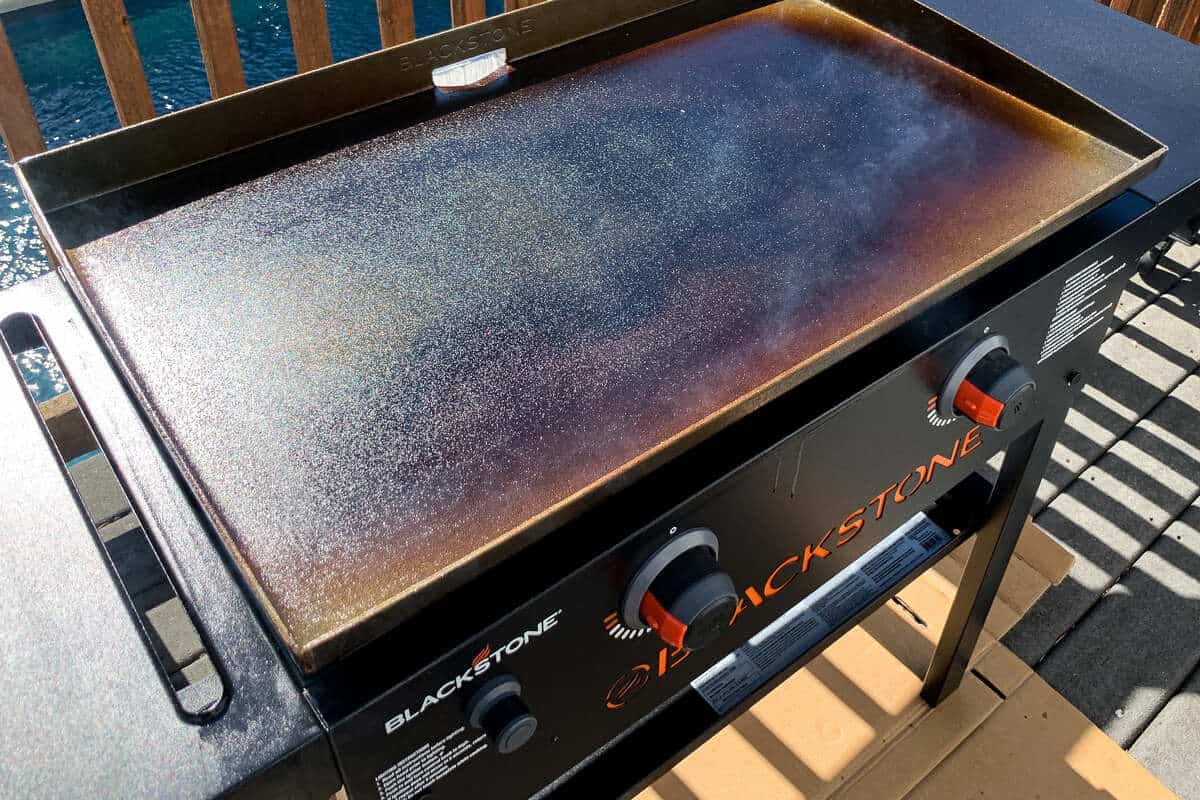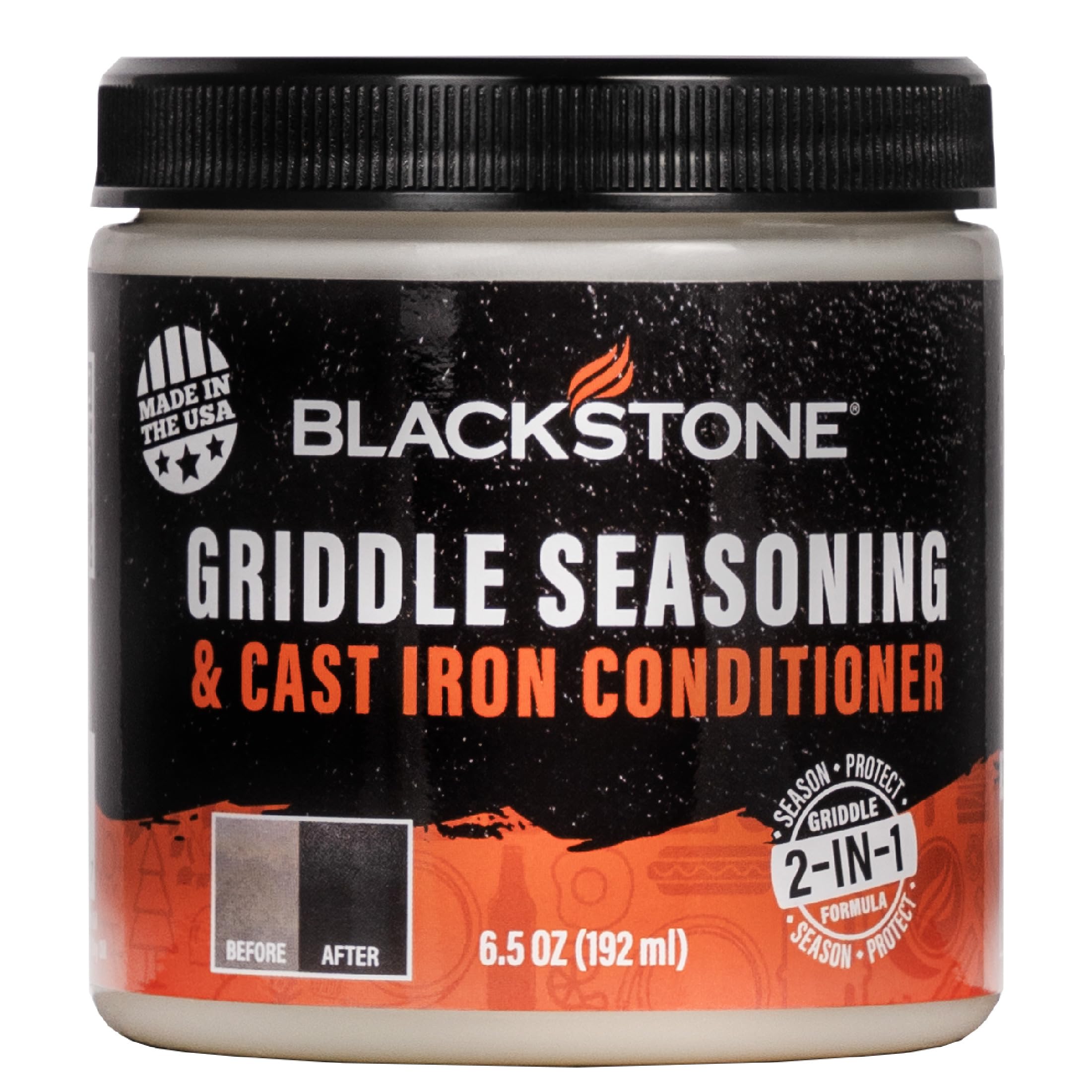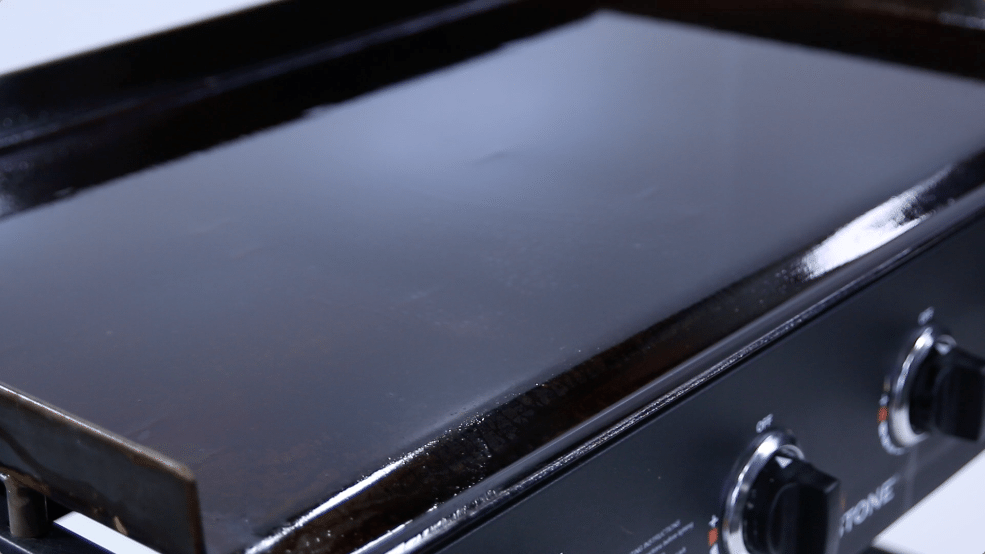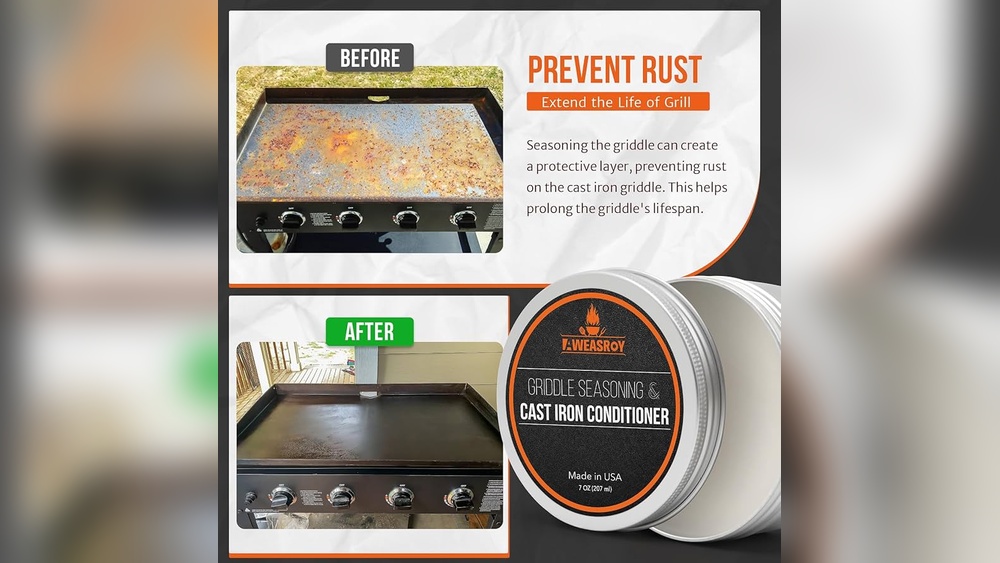If you own a Blackstone griddle or are thinking about getting one, you’ve probably heard how important seasoning is. But what exactly is in Blackstone griddle seasoning, and why does it matter for your cooking?
Understanding what goes into this seasoning can help you create a non-stick surface that cooks your food evenly and tastes amazing every time. You’ll discover the key ingredients and learn why each one plays a role in protecting your griddle and enhancing your meals.
Keep reading to unlock the secrets behind Blackstone griddle seasoning and take your outdoor cooking to the next level.

Credit: www.madbackyard.com
Blackstone Griddle Basics
The Blackstone griddle is a popular cooking tool for outdoor meals. It has a flat, smooth surface that heats evenly. This design makes it perfect for cooking many foods like pancakes, burgers, and vegetables.
Seasoning the griddle is a key step. It means coating the surface with oil and heating it. This process creates a natural non-stick layer that protects the griddle. It also improves cooking performance and flavor.
Purpose Of Seasoning
Seasoning protects the griddle from rust and damage. It forms a thin, hard layer on the metal surface. This layer prevents moisture from reaching the metal. It also stops food from sticking during cooking. Seasoning helps keep the griddle clean and in good shape.
Benefits Of Proper Seasoning
Proper seasoning makes cooking easier and better. Food slides off smoothly without sticking. Cleaning the griddle becomes quick and simple. Seasoning also adds flavor to the food over time. It helps the griddle last longer and stay strong.
Core Ingredients In Seasoning
Seasoning a Blackstone griddle is essential for great cooking and long-lasting performance. The seasoning blend adds flavor and protects the griddle surface. Understanding the core ingredients helps you appreciate what makes the seasoning effective and tasty.
Each ingredient plays a role in enhancing the taste of your food. The balance of spices creates a versatile mix for many dishes. Here are the main components found in Blackstone griddle seasoning.
Salt And Pepper Blend
Salt is a key ingredient that enhances the natural flavor of food. It also helps create a nice crust on grilled items. Black pepper adds a mild heat and sharpness. This combination forms the base of the seasoning mix. It suits a wide range of meats and vegetables.
Garlic Components
Garlic in the seasoning brings a rich, savory flavor. Often, garlic powder or granules are used for easy blending. It adds depth without overpowering other spices. Garlic enhances the aroma and taste of grilled dishes. This component is popular in many seasoning blends.
Other Common Spices
Besides salt, pepper, and garlic, other spices may be included. Onion powder is common for a subtle sweetness and aroma. Paprika can add a mild smoky flavor and color. Some blends include herbs like thyme or oregano for extra zest. These spices work together to create a balanced flavor profile.
Oils Used For Seasoning
Oils play a key role in Blackstone griddle seasoning. The right oil creates a strong, non-stick surface. It protects the metal from rust and adds flavor. Choosing the best oil depends on smoke point and drying ability. Some oils polymerize well, forming a solid, durable coating. Others may burn or leave sticky residues. Understanding which oils work best helps keep your griddle in top shape.
Flaxseed Oil Advantages
Flaxseed oil is popular for seasoning griddles. It has a high smoke point around 225°C (437°F). This means it can handle the heat without burning quickly. Flaxseed oil dries and hardens into a tough, smooth layer. This layer sticks well and resists peeling. It also contains omega-3 fatty acids that help polymerize the oil fast. Many griddle users prefer flaxseed oil for its strong, durable coating.
Alternative Oils: Avocado, Grapeseed, And More
Avocado oil has a very high smoke point near 270°C (520°F). It works well for seasoning and lasts long. Grapeseed oil is another good choice. It has a smoke point around 216°C (421°F). Both oils dry well and create good seasoning layers. Other options include sunflower and canola oils. These oils are easy to find and affordable. They offer decent results for regular griddle care.
Oils To Avoid
Olive oil is a common oil to avoid. Its low smoke point causes it to burn and smoke quickly. Burnt oil can leave sticky, uneven seasoning layers. Butter or animal fats also burn too fast. These fats do not create a strong polymerized coating. Avoid oils that smell rancid or have strong flavors. These can affect the taste of your food and damage the seasoning.
Seasoning Process Steps
The seasoning process is key to protecting your Blackstone griddle and improving its cooking surface. It creates a natural non-stick layer that prevents rust and adds flavor to your food. The process involves heating, applying oil, and repeating steps to build a strong coating.
Heating The Griddle
Start by turning on your griddle to medium-high heat. Let it warm evenly for about 10 to 15 minutes. Heating opens the metal’s pores, allowing the oil to bond better. You want the surface hot but not smoking heavily.
Applying The Seasoning
Use a cloth or paper towel to spread a thin, even layer of oil over the hot griddle. Oils like flaxseed, canola, or grapeseed work best. Avoid thick coats; excess oil can cause sticky spots. Rub the oil thoroughly to cover every inch of the cooking surface.
Building Multiple Layers
After the first layer, let the griddle heat until the oil starts to smoke slightly. Then turn off the heat and let it cool. Repeat the oil application and heating steps 2 to 3 more times. Each layer adds durability and improves the non-stick finish.
Seasoning Challenges
Seasoning a Blackstone griddle is essential for a smooth cooking surface and lasting protection. The process can be tricky and often leads to frustration. Many users face challenges that cause uneven seasoning or sticky residue. Understanding these challenges helps create a perfect, non-stick surface.
Common Mistakes
Using too much oil is a frequent error. It creates a sticky, uneven layer instead of a smooth coating. Applying oil on a cold griddle reduces absorption and causes peeling. Not heating the griddle properly leads to poor seasoning results. Skipping the cleaning step allows dirt to block the oil from bonding.
Myths And Rumors
Some believe seasoning requires special oils only. In truth, many common oils with high smoke points work well. Another myth is that seasoning is a one-time step. It needs regular maintenance for best results. Some say seasoning adds flavor; it mainly protects and prevents rust.
Troubleshooting Tips
Start with a clean griddle before seasoning. Use thin layers of oil and spread it evenly. Heat the griddle to the right temperature to polymerize the oil. If sticky spots appear, scrub lightly and reseason. Repeat seasoning several times for a durable surface. Avoid using olive oil or animal fats as they burn easily.
Maintaining Seasoned Griddle
Maintaining a seasoned Blackstone griddle ensures better cooking and longer griddle life. Seasoning builds a natural, non-stick surface that protects the metal. Proper care keeps this layer strong and ready for your next meal. Follow simple steps to clean and re-season your griddle regularly. This way, the seasoning stays effective and the griddle works well for years.
Cleaning Tips
Clean the griddle after each use while it is still warm. Use a scraper to remove food bits and grease. Avoid soap, as it can strip the seasoning. Instead, wipe the surface with a damp cloth or paper towel. For tough spots, use hot water and a griddle scrubber. Dry the griddle completely to prevent rust.
Re-seasoning Frequency
Re-season your griddle every few months or when food starts sticking. Also, re-season after deep cleaning or rust removal. Apply a thin layer of cooking oil over the surface. Heat the griddle until the oil smokes and forms a new protective layer. This keeps the non-stick surface smooth and durable.
Extending Seasoning Longevity
Cook with oils that have high smoke points like canola or flaxseed oil. Avoid cooking acidic foods often, as they can wear down seasoning. Store your griddle in a dry place to prevent rust. Regularly wipe the griddle with a light coat of oil after use. These steps help keep the seasoning strong and lasting.
Seasoning Variations And Alternatives
Seasoning a Blackstone griddle helps protect its surface and improves cooking results. Many users explore different seasoning options beyond the original Blackstone formula. These variations offer flexibility based on preference, budget, and ingredient availability. Experimenting with alternatives can lead to a well-seasoned griddle that lasts longer and cooks better.
Cast Iron Conditioner Options
Cast iron conditioners work well on Blackstone griddles too. These products often contain natural oils and waxes. They create a strong, protective layer on the metal. Popular conditioners include flaxseed oil, coconut oil, and beeswax blends. Each option varies in durability and ease of use. Choosing one depends on your personal seasoning routine and desired finish.
Homemade Seasoning Blends
Many cooks prefer homemade blends for seasoning their griddles. These usually combine oils with natural ingredients like garlic or herbs. Flaxseed oil is a favorite because it polymerizes well under heat. Other oils such as grapeseed, avocado, or vegetable oil also work. Homemade blends allow control over the ingredients and avoid additives found in some commercial products.
Commercial Seasoning Products
Commercial seasoning sprays and oils offer convenience and consistent results. Blackstone itself sells seasoning oils designed for their griddles. Other brands produce cast iron or grill seasoning products suitable for Blackstone surfaces. These often contain canola or soybean oil and additives to improve shelf life. Using commercial products can save time and ensure an even protective coating.

Credit: www.brandclub.com

Credit: blackstoneproducts.com
Frequently Asked Questions
What Ingredients Are In Blackstone Griddle Seasoning?
Blackstone griddle seasoning typically contains canola oil, flaxseed oil, or other high-smoke-point oils. It may also include salt, pepper, and garlic. The blend ensures a durable, non-stick surface for cooking. Avoid using olive oil or animal fats for seasoning.
Do I Need Griddle Seasoning For Blackstone?
Yes, seasoning your Blackstone griddle is essential for non-stick cooking and rust prevention. Use high-smoke-point oils like flaxseed or avocado oil. Regular seasoning enhances flavor and extends griddle life.
What Is In Blackstone Essential Seasoning?
Blackstone Essential seasoning contains salt, pepper, and garlic. It provides a versatile blend for all meat cuts and dishes.
What Are The Ingredients In Blackstone All Purpose Seasoning?
Blackstone all-purpose seasoning contains salt, black pepper, garlic powder, onion powder, and other natural spices. It enhances flavor on various dishes.
Conclusion
Blackstone griddle seasoning mainly includes oils with high smoke points. Oils like canola, avocado, and flaxseed work best. These oils help create a strong, non-stick surface. Seasoning protects the griddle from rust and improves cooking. Using the right oil and heat ensures long-lasting results.
Proper seasoning makes your griddle easier to clean. Keep your Blackstone griddle ready for tasty meals. Simple steps lead to better cooking experiences every time.

